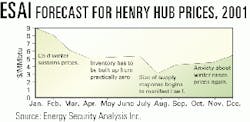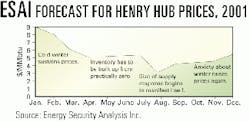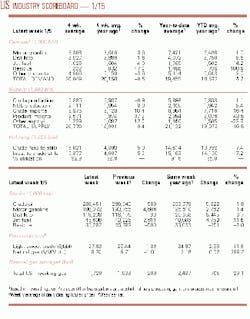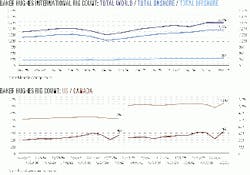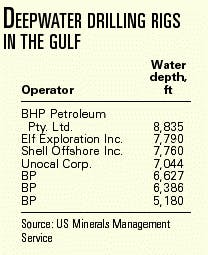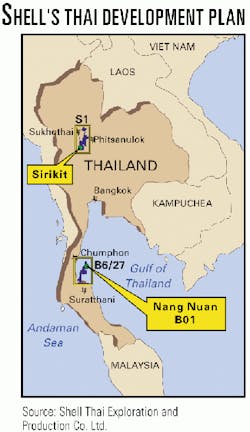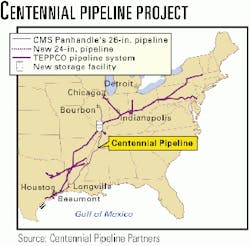OGJ Newsletter
Market Movement
Power demand to sustain high gas prices
While cold weather has sustained US natural gas prices at unprecedented levels, the outlook for continued high gas prices in the coming decade owes more to burgeoning demand for gas from the electric power sector.
That's the view of Ed Krapels, director of Energy Security Analysis Inc.'s natural gas and power practice, who contends that demand from the electric generation sector is the main culprit for extreme price volatility in the natural gas market.
"Gas prices will average $6[/MMbtu] in years when hot summers follow cold winters and $3[/MMbtu] in years when cool summers follow mild winters," Krapels said. "This is the central and irreducible consequence of the choice made over the last 5 years to make natural gas the primary fuel for generating new electricity supplies."
As far as 2001 is concerned, it already shapes up as a year with a very cold winter, leading ESAI to project an average gas price of $5.33/MMbtu-a projection it deems too low if summer proves to be very hot (OGJ, Jan. 8, 2001, Newsletter, p. 5).
"This is a significant development, considering that natural gas prices have averaged approximately $2/MMbtu over the past 10 years," Krapels said.
Gas price factors
ESAI cites four key factors that will affect gas prices in 2001 (see chart).
- The weather. If the first quarter is as cold as November-December was and a really hot summer throughout the US follows, that's a recipe for an average Henry Hub price of $6-7/MMbtu for the full year, ESAI contends. If this winter turns mild, followed by a temperate summer throughout the US, the price is likely to average $3-4/MMbtu for the full year.
- The supply response. "No one is investing serious capital in gas resource development that requires $5[/MMbtu] for 10 years, nor should they," Krapels said. "The supply response that we can expect in 2001 and 2002 is based on sustainable $3-4 gas."
- The inventory level and consequent prices. Incremental supply will be swallowed by higher demand in the first quarter, keeping prices buoyed at $8-9/MMbtu early in the period and drifting down to $6/MMbtu in March, ESAI contends: "During the second quarter, the incremental supply will be sucked into a nearly depleted stockpile."
- The demand response from consumers dependent on natural gas for space heating. The analyst contends that residential consumers will conserve aggressively and that demand from power producers will continue to grow as more gas-fired electricity capacity will come on line in 2001.
Inventory squeeze
The squeeze on US natural gas storage will ensure that gas prices remain bolstered in 2002-and probably beyond, says Lehman Bros.' Thomas Driscoll.
"We expect to exit winter with storage at about 200-400 bcf vs. a normal level of around 1,000 bcf," he said. "Industry is unlikely to be able to refill storage for next winter; thus, low inventory levels will likely continue to exert upward pressure on gas prices for a prolonged period of time."
Accordingly, Lehman Bros. last week hiked its 2001 natural gas price forecast to $6.25/MMbtu from an earlier forecast of $5/MMbtu and its 2002 natural gas price projection to $4.50/MMbtu from $4.15/MMbtu. Don't look for US natural gas production to come to the market's rescue anytime soon, Lehman Bros. contends. "We estimate that US natural gas production has fallen nearly 7% over the past 3 years," Driscoll said. "We think that US natural gas production is back to 1990 levels.
"Although [third quarter 2000] probably represented the production trough, we believe that production will rise more slowly this year than is expected by many investors. We are forecasting a production increase of 1-2% in 2001."
Crimping demand
The key to balancing US gas markets, says Driscoll, may be "demand destruction."
"Clearly, current high prices are causing decreases in consumption by many industrial and perhaps commercial customers," he said. "In the fourth quarter, we estimate that heating demand increased by 564 bcf compared with [fourth quarter] 1999 levels; this demand increase was met not by supply growth but by a 301 bcf increase in storage withdrawals plus a 263 bcf decreased in nonheating consumption." With fourth quarter natural gas spot prices averaging about $6.25/MMbtu, Lehman Bros. thinks that nonheating demand for gas fell in the period by 2.9 bcfd.
"Thus we expect that a first quarter average price of $8-10/MMbtu would cause an even larger demand response," Driscoll said.
null
null
null
Industry Trends
US deepwater drilling rigs in the gulf of mexico hit a record high.
The US Minerals Management Service said that the number of rigs drilling in the deep waters of the Gulf of Mexico hit a record high of 40 last month.
In 1999, "there were only 26 rigs working in the deepwater portion of the Gulf of Mexico. But that number continued to rise, making 2000 a record-setting year," said MMS Director Walt Rosenbusch.
The MMS defines deep water as 1,000 ft or more. Of the 40 deepwater wells now being drilled in the gulf, officials said, 33 are in depths of 1,500 ft or greater.
"The number of wells being drilled in the so-called ultradeep water-5,000 ft or greater-continues to grow," Rosenbusch said. "Currently, there are seven wells being drilled in water depths of 5,000 ft or greater; three in excess of 7,500 ft (see table)."
SALOMON Smith Barney predicts A $5 billion jump in exploration THIS YEAR.
Salomon Smith Barney has predicted the 10 largest oil and gas companies will use their higher profits from oil price increases in 2000 to invest $5 billion more this year in exploration. It estimated their exploration spending would in- crease 14% to $40.7 billion. Salomon Smith Barney said the companies' investment in exploration rose less than 5% in 2000. The analyst said that investments in other drilling would climb 20% this year to $20 billion, the largest expansion in 2 decades. It said most of the spending would be in regions outside the US, such as the Caspian Sea and the West African states of Angola and Nigeria.
The analyst said the majors' average oil price assumption for 2001 E&P planning was $25/bbl and their longer-range yardstick was $23/bbl.
Thailand IS promoting CNG use for vehicles.
Thailand, which uses its considerable gas reserves to meet a third of its total commercial petroleum requirement, is promoting natural gas as vehicular fuel.
The high oil price is prompting use of compressed natural gas (CNG) in the kingdom's transportation sector. Thai energy planners have wanted more CNG use in vehicles for nearly a decade but were thwarted by low oil prices and the high cost of CNG vehicles. The cabinet-approved plan would promote natural gas vehicles. About 60% of Thailand's commercial petroleum demand-904,200 b/d in the first 9 months of 2000-is used for transportation.
Thai energy authorities want to back out 10% of total oil use in the transportation sector with natural gas in the next 5 years through a program estimated to cost 959 million baht ($22.83 million).
Government Developments
Fance's Constitutional Council rejected a proposed ecotax.
France's proposed ecotax, designed to enforce a reduction in industrial greenhouse gas emissions, was dealt a death blow this month when the country's Constitutional Council declared it unconstitutional.
The council said that extending the General Tax on Polluting Activities to include the corporate use of intermediate energies was unconstitutional for two main reasons. One was that the complicated structure of the tax contravened the basic rule of tax equality. The other was that, because the purpose of the tax is to curb greenhouse gas emissions, it should not be applied to France's electricity industry, where 80% of generation is from nuclear or hydropower-sources that emit no greenhouse gases.
Representatives of the oil and chemical industries expressed satisfaction at the council's decision. But France's environment ministry said it would seek other ways to meet France's target of saving 15 million tonnes/year of carbon equivalent by 2010.
Pres. Clinton this month approved a US Forest Service proposal to prevent road construction on 58.5 million acres of forest lands in 39 states, about a third of the national forests.
The White House said all activities on roadless lands that already were the subject of a Forest Service decision, such as leases and permits, will continue to be permitted.
It said, "Existing oil, gas, coal and other leaseable mineral development can continue after existing leases expire if they are immediately renewed or reissued. The rule will have only very minimal impact on the nation's future supply of natural gas and other energy sources."
The White House said the program to set aside roadless lands reflects input received at more than 600 public meetings nationwide attended by an estimated 39,000 people. In developing the strategy, the Forest Service received 1.6 million comments from the public and collaborated with seven other federal agencies.
Last week, Rep. Jim Hansen (R-Utah), the new House resources committee chairman, urged Pres.-Elect George W. Bush to work with Congress to revoke the expected roadless lands rule. Several western senators said they would seek legislation in the next Congress to overturn the rule.
Sen. Frank Murkowski (R-Alas.) predicted the initiative would be overturned in court. Murkowski said the roadbuilding ban would block the development of large reserves of gas in the West.
ExxonMobil PLANS to fight a Texas royalty LAWsuit.
ExxonMobil will fight a Texas lawsuit alleging it wrongly failed to pay royalties from a field over a 25-year period. It called the allegations "unfathomable" and called the request for punitive damages "ridiculous and illogical." On Jan. 4, Texas Atty. Gen. John Cornyn filed the suit, which seeks damages "in the tens of millions" of dollars.
ExxonMobil said the suit involved Hawkins field in the southeastern tip of Wood County. The field was discovered in 1940, and Texas approved the unitization in 1975, said ExxonMobil. Texas owns 50 acres of right-of-way along US Highway 80, which runs through the field. The oil company apparently did not pay any royalties but claims no such payment was required.x
Quick Takes
Royal Dutch/Shell plans to spend 80% more this year on oil development in Thailand than it did in 2000.
Thai Shell E&P plans to spend up to $73 million in 2001 on development of oil reserves.
The increase reflects the company's effort to sustain crude oil output from the 15-year-old Sirikit field in the northern province of Kamphaeng Phet and to revive oil production from a Gulf of Thailand field that was shut in 4 years ago (see map).
Luechai Wongsirasawad, deputy executive director of Thai Shell, said $65 million will be spent to sustain Sirikit production at 24,000-25,000 b/d of oil. About $35 million of that will be spent on oil production facilities, including a waterflood system. And $30 million would be used to drill 28 development wells in Sirikit as well as two wildcats outside the Sirikit production area.
At the same time, Thai Shell decided to allocate about $8 million to drill two wells on its oil-bearing B6/27 concession block in the Gulf of Thailand, beginning around March.
The wells will be drilled back-to-back in Nang Nuan, a field off southern Thailand's Chumphon coast that produced 4.25 million bbl of oil before excessive water intrusion forced the operator to halt production in January 1997.
In other development action, Norsk Hydro confirmed that reserves at its Oseberg East development may increase by 15 million bbl following an oil discovery in the Norwegian North Sea field area with its 30/6-E-5 well. The find, according to a Hydro spokesman, was made after the exploration well was extended 500 m into Dunlin formation on the Beta Sadel North structure, reaching TD at 5,490 m. Drilled from Oseberg East's integrated drilling, accommodation, and production platform, the well also found oil "in several intervals" in the Brent formation. Output from Oseberg East, aided by water and gas injection, is 75,000 b/d. Production, which is initially processed at the field platform, is piped 25 km to Oseberg Field Center for second and third-stage processing. It then is moved through the Oseberg Transport System pipeline to the onshore Sture oil terminal operated by Hydro. Total reserves for the field, which came on stream in April 1999, were first estimated at 145 million bbl of oil. Owners are Hydro (operator) with 19.6%, Statoil with 14%, TotalFinaElf with 14%, and ExxonMobil with 7%. Norway's direct financial interest is 45.4%.
Cairn Energy said that it is considering development options for a second oil and gas find on Block CB-OS/2 off Gujurat in western India. Two zones in the Ambe discovery, made via the CB-C-1 exploration well, flowed a combined 41 MMcfd of gas through a 96/64-in. choke, while a third zone flowed oil at rates of 150-500 b/d. The gas from Ambe is dry methane with no CO2 or H2S, according to Cairn, while the crude is 25° gravity with a low gas-to-oil ratio of 120:1. The company hopes to firm up its gross reserves estimates at Ambe, which are 50-200 bcfe, through appraisal drilling in the first quarter.
Operator Phillips Petroleum Pty. awarded a "substantial" hook-up and commissioning contract for the Timor Sea Bayu-Undan gas recycle project to Aker Maritime and its Australian partner Clough Engineering. Work on the $90 million (Aus.) contract, won by the 50-50 Aker Maritime-Clough JV, will begin immediately, said Aker, with completion for start-up scheduled in early 2004. The work scope covers commissioning of the wellhead platform; drilling, production, and processing topsides; and the compression, utilities, and accommodation topsides. Work will be carried out in yards in Singapore and South Korea. Activities offshore include the hook-up and commissioning of all facilities of the entire field production systems, along with the floating condensate and LPG storage and offloading facilities.
McMoRan Exploration reported success at two exploration wells in the Gulf of Mexico.
The company plans to begin production from both in the second quarter. McMoRan's third well on Eugene Island Block 193, on the North Tern deep prospect, found gas pay at 16,460-16,613 ft and 16,790-16,952 ft. The company said that the sands are twice as thick as indicated by 3D seismic data and that reserves could be 100 bcf or more. The well will be completed using the Eugene Island 193-A platform. Production is estimated at 50 MMcfd of gas.
On Main Pass Block 986, a step-out 1 mile northwest of the discovery on the Shiner prospect found pay at 2,668-2,688 ft. McMoRan said the Shiner discovery and stepout could produce more than 25 MMcfd of gas.
Elsewhere on the exploration front, CNOOC is expected to focus on gas exploration and production over the next 5 years. An initial plan calls for the company to develop 370-600 billion cu m of gas reserves by 2005 in order to increase production to 10 billion cu m/year from 4 billion cu m now. CNOOC plans a feasibility study this year with Royal Dutch/Shell for a 2,000-km gas pipeline skirting China's eastern coast. It would move gas from the South China Sea, East China Sea, and Bohai Sea to markets in eastern provinces. CNOOC will center its gas exploration and production in the Yinggehai and Qiongdongnan basins in the South China Sea, following exploration failures last year in East China Sea's Xihu Sag, a gas province. CNOOC's partners in Xihu Sag are Shell and Sinopec Star Petroleum.
Dragon Oil of the UK said it spudded the first of three planned wells in Lam field off Turkmenistan in the eastern Caspian Sea after a delay of 3 months. The company speculates that there may be resources of 600 million bbl of oil and 2.2 trillion cu m of gas on the Cheleken block. The three wells will be the first on the block in more than 10 years.
Apache said last week a preliminary open-hole test of its Tuchola 108-2 wildcat on its Pomeranian concession in northwestern Poland flowed 9.5 MMcfd of gas, the limit of the surface equipment. The well is Apache's first on the concession. The gas was from the secondary objective, a 200-ft gross interval in the Permian main dolomite at 8,318-8,514 ft. Drilling will continue toward the primary objective, the Devonian sand.
Marathon and Kinder Morgan have formed a CO2 joint EOR venture.
Marathon Oil and Kinder Morgan Energy Partners said they have formed a JV covering carbon dioxide enhanced oil recovery in Yates field and the Scurry Area Canyon Reef Operators Committee (SACROC) Unit in the Permian basin of West Texas.
Under the deal, Kinder Morgan will buy 15% of Marathon's working interest in Yates field of southeast Pecos County. Marathon is operator. During the first 9 months of 2000, Marathon's production from Yates was 14,700 b/d, or 11% of the company's US production. Kinder Morgan will contribute its resulting 7.5% overall working interest in Yates to the JV, while Marathon adds its resulting 42.4% interest in that field.
Marathon also will contribute its 10.84% working interest in SACROC, located in Kelly-Snyder field in Scurry County. Kinder Morgan will contribute 1.91% working interest in SACROC, retaining 71% ownership in that unit, officials said.
Marathon used CO2 as part of its EOR program in Yates field in the early 1990s but subsequently switched to nitrogen because of pricing.
Kinder Morgan expects to help reestablish CO2 flooding in Yates field and has contracted to supply Marathon with 30 bcf of CO2.
Marathon will handle operations for the Yates JV, while Kinder Morgan will provide the same duty in SACROC. But any new CO2 projects in either field as a result of the JV are still 12-18 months away, officials said.
In other production news, India's ONGC plans to spend $645 million to redevelop the northern portion of Bombay High field under a plan submitted by UK-based technical consultants Gaffney, Cline & Associates. The government-owned company said last year it would redevelop both parts of Bombay High (OGJ Online, Nov. 20, 2000).
Petrobras sold its Petrobras XX floating production unit to Westdeutsche Landesbank for $200 million. Petrobras will continue to operate the unit through a lease contract for 10 years, with the option to buy it back. The cost of the operation is 9.3%/year over the 10-year contract, the company said. Petrobras XX has capacity to produce some 61,500 b/d in 610 m of water. The unit will continue to operate in Marlim oil field in Brazil's Campos basin off Rio de Janeiro state.
Petroleum Geo-Services said the upgrade of the Ramform Banff floating production, storage, and offloading vessel is complete, and the vessel will leave the shipyard in mid-January. PGS said last year the modification would reduce the FPSO's roll motion by 50% and cost less than $20 million (OGJ Online, Sept. 7, 2000).
CENTENNIAL PIPELINE HAS AWARDED A CONTRACT FOR A GAS PIPELINE CONVERSION.
Centennial awarded a contract to Willbros Group subsidiaries Willbros Engineers and Rogers & Phillips for project management, engineering, procurement, field services, and construction of pipeline components for its liquids transportation system.
The project scope includes construction of 74 miles of 24-in. pipe from Beaumont, Tex., to Longville, La., and conversion of an existing 720-mile, 26-in. gas pipeline from Longville to Bourbon, Ill., to refined products service (see map).
Centennial Pipeline is a venture of Marathon Ashland Petroleum, Panhandle Eastern Pipe Line, and TE Products Pipeline. Project approval from regulatory agencies is expected this year.
In other pipeline action, Enter- prise Products Partners said it has agreed to exchange finished NGL products from its Mont Belvieu, Tex., complex for NGL from the Sea Robin gas processing plant in Vermilion Parish, La. The NGLs will be exchanged via Enterprise's recently completed 12-in., 206-mile Lou-Tex NGL pipeline, which links supplies in Louisiana and Mississippi to the NGL market hub at Mont Belvieu. Under the 5-year deal with Sea Robin's owners, Enterprise will ship the NGL through Lou-Tex, provide storage, and process the liquids into ethane, propane, normal butane, isobutane, and natural gasoline at its 210,000 b/d Mont Belvieu fractionator. The agreement will take effect when the Sea Robin plant is linked to Enterprise's NGL system by pipeline in March. Initial volumes are expected to be 16,000 b/d but may increase to more than 20,000 b/d by yearend.
Sui Southern Gas, the Pakistan utility that supplies gas to Sindh and Baluchistan provinces, plans to invest 4 billion rupees ($70 million) over 2 years to rehabilitate and expand its distribution infrastructure. Managing Director Mukhtar Ahmed said 1 billion rupees would be invested this year. He said the investment is essential to meet growing gas demand. Pakistani demand is projected to increase to 3.9 bcfd by 2010 from 2.45 bcfd in 2000. He said that the company expects 500 MMcfd of gas from five new fields: Hasan, Zamzama, Miano, Sawan, and Bhit.
CHINA AGAIN HAS DELAYED AWARDING A CONTRACT TO BUILD A $600 MILLION LNG TERMINAL AT SHENZHEN IN SOUTHERN CHINA.
The tender award had been expected Dec. 18 but was postponed to Dec. 24. It was again delayed, and no date has been set for the announcement.
A Chinese consortium led by CNOOC submitted bidder-assessment reports to the government more than a month ago.
The four bidders are China Australia Terminal and Korea Gas; a consortium of ExxonMobil, Hong Kong China Light Power, and Chubu Electric Power; a consortium of Royal Dutch/Shell, Marubeni, and Osaka Gas; and BP. They are bidding for a 30% stake in a JV with the CNOOC consortium to build a 3 million tonne capacity LNG terminal in Shenzhen.
